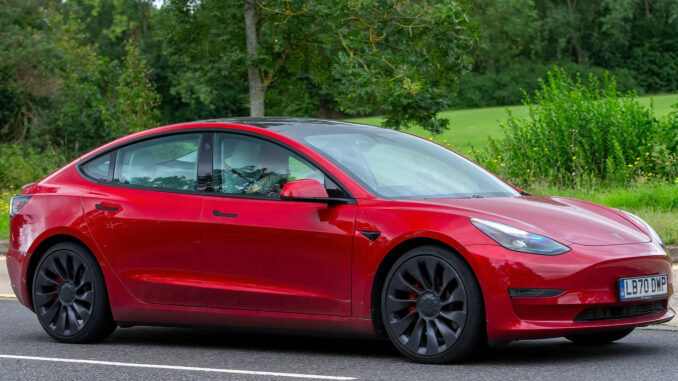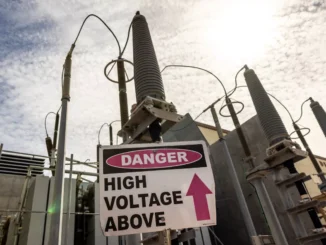
Electric vehicles release more toxic particles into the atmosphere and are worse for the environment than their gas-powered counterparts, according to a resurfaced study.
The study, published by emissions data firm Emission Analytics, was released in 2022 but has attracted a wave of attention this week after being cited in a Wall Street Journal op-ed Sunday.
It found that brakes and tires on EVs release 1,850 times more particle pollution compared to modern tailpipes, which have “efficient” exhaust filters, bringing gas-powered vehicles’ emissions to new lows.
Today, most vehicle-related pollution comes from tire wear.
As heavy cars drive on light-duty tires — most often made with synthetic rubber made from crude oil and other fillers and additives — they deteriorate and release harmful chemicals into the air, according to Emission Analytics.
Electric vehicles release more toxic particles into the atmosphere due to tire wear, according to Emission Analytics, which said battery-powered cars are more than 30% heavier than their gas-powered counterparts.
Because EVs are on average 30% heavier, brakes and tires on the battery-powered cars wear out faster than on standard cars. Emission Analytics found that tire wear emissions on half a metric tonne of battery weight in an EV are more than 400 times as great as direct exhaust particulate emissions.
For reference, half a metric tonne is equivalent to roughly 1,100 pounds. The most popular EV in the US, Tesla’s Model Y, boasts a lithium-ion battery that weighs in at a hefty 1,836 pounds.
Another sought-after electric model, Ford’s F-150 Lightning pickup truck, also has an approximately 1,800-pound battery.
Emission Analytics found that tire wear emissions with about 1,100 pounds of battery weight in an EV are more than 400 times as great as direct exhaust particulate emissions. Most EV batteries weigh around 1,800 pounds. Emissions Analytics
The study throws doubt on the practicality of the Biden administration’s EV mandates, which tout electric cars as “zero-emissions vehicles” in a quest to force two-thirds of new cars in America to be all-electric by the year 2032.
California lawmakers have similarly referred to EVs as producing “zero emissions” because they don’t have tailpipes, per the Journal, which added that the label is “deceptive.”
Electric cars still use tires made from petroleum that create particle pollution as they wear.
Still, “this will not be something that stops electrification,” Nick Molden, the founder and CEO of Emissions Analytics, told The Post.
“You have a tradeoff. At the moment, the political agenda is very strong towards climate change reduction. EVs do deliver about a 50% reduction in CO2 — that [affects] climate change.”
“But you have this downside of EVs that increases particle pollution. Air pollution is about what we breathe and the health effects,” Molden said, assuring that the toxins in tires have much less impact on climate change than they do on “what we eat and are ingesting.”
“Tires are made up of a lot of nasty chemicals,” said Emissions Analytics chief Nick Molden. To combat the release of toxins as they wear, Molden said that tires need to be made of more sustainable materials.
Increased exposure to these toxins “can increase the risk of health problems like heart disease, asthma, and low birth weight,” according to the New York Department of Health, which noted that pollution from sources including vehicle exhaust can travel long distances from its source and still cause health issues at unhealthy levels.“A lot of it [chemicals] goes into the soil and water, affecting animals and fish. And we then go and eat the animals and fish, so we are ingesting tire pollution,” Molden added.“Tires are made up of a lot of nasty chemicals.”Molden said that “the best first thing” to do to address this problem is to “change the recipe, minimize a number of toxic chemicals in the tires — then you got the best of both worlds.
Even so, California’s air agency used a model that assumes electric and gas vehicles have the same amount of tire wear when analyzing the effects of the ban, according to the Journal.
Emissions Analytics found that brakes and tires on EVs release 1,850 times more particle pollution compared to modern tailpipes, which have “efficient” exhaust filters, bringing gas-powered vehicles’ emissions to new lows.Megan Mendoza/The Republic / USA TODAY NETWORK
The public was quick to note the error, but the agency doubled down on its stance, saying it’s “speculative” to assume electric cars will always be heavier than their gasoline counterparts.
California’s Air Resources Board (CARB) insisted in its “Final Statement of Reasons for Rulemaking” that automakers could “offset” the weight of heavy batteries with “weight reduction in other components or the vehicle body,” though the agency didn’t specify how.
The Environmental Protection Agency has also shared plans to ratchet up emissions standards starting with the 2027 model year to force automakers to sell ever fewer gas-powered and even hybrid cars.
The Post has sought comment from CARB and the Environmental Protection Agency.



